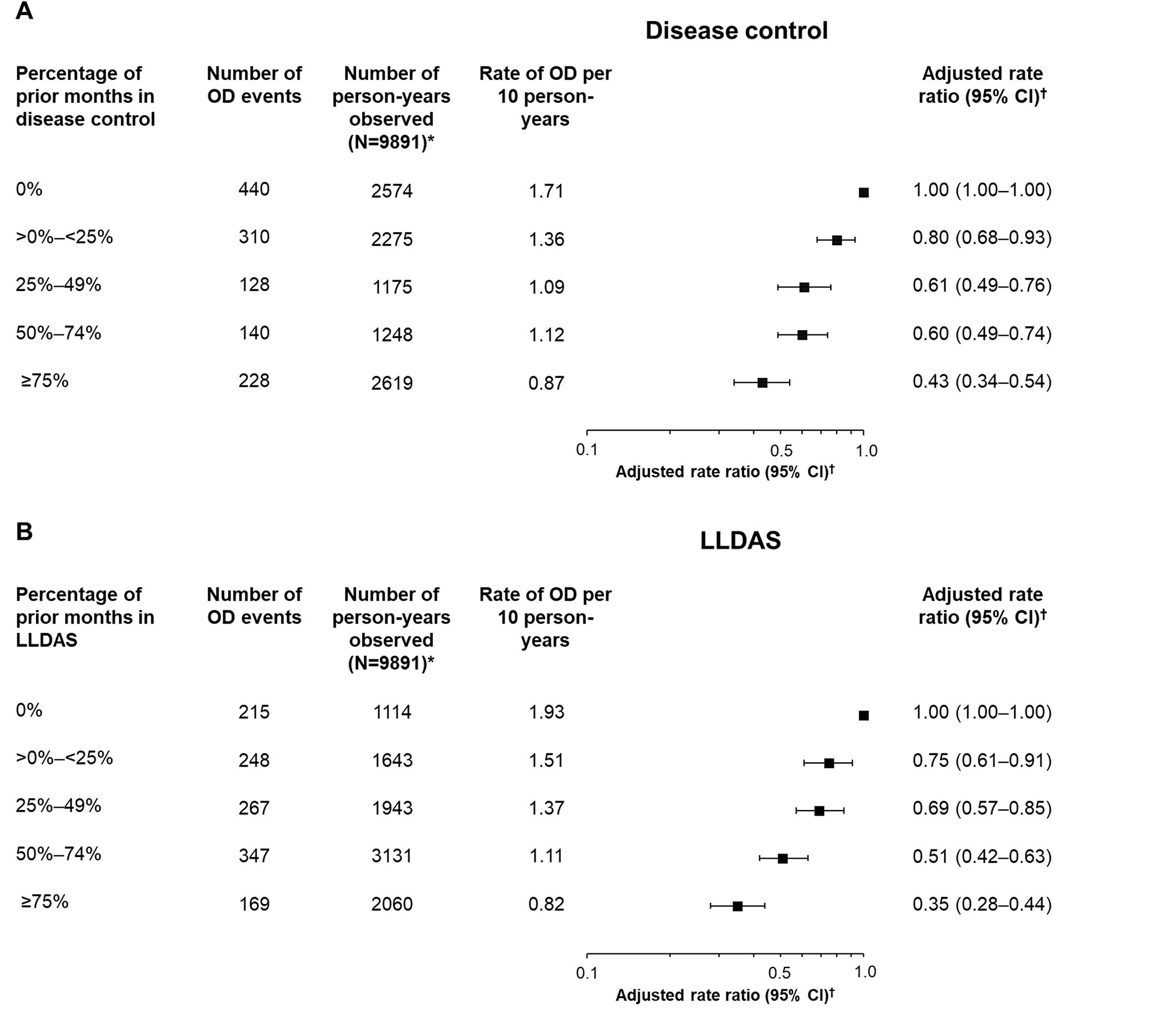Session Information
Date: Monday, November 14, 2022
Title: SLE – Diagnosis, Manifestations, and Outcomes Poster III: Outcomes
Session Type: Poster Session D
Session Time: 1:00PM-3:00PM
Background/Purpose: The treatment target for systemic lupus erythematosus (SLE) is remission or, if this cannot be reached, the lowest disease activity achievable with the least cumulative steroid exposure necessary to control the disease.1 For patients (pts) with SLE, longer periods of low disease activity states are associated with reduced rates of long-term organ damage (OD).1–3 We quantified the association between time in specific SLE disease activity states (disease control and low lupus disease activity state [LLDAS]) and rate of long-term OD using data from the Hopkins Lupus Cohort study.4
Methods: This observational, retrospective analysis (GSK Study 207168) included pts enrolled for ≥1 year in the Hopkins Lupus Cohort and aged ≥18 years at enrollment, with index defined at 1-year after enrollment. For each month of follow-up, we classified pts as being in disease control or LLDAS based on SLE disease activity (measured using SLEDAI or Physician Global Assessment [PGA]) and medication use recorded at standard of care visits. Disease control was defined as SLEDAI ≤2, prednisone-equivalent dose ≤5 mg/day, with use of biologics permitted but no use of immunosuppressants. LLDAS was defined as SLEDAI ≤4, PGA ≤1, prednisone-equivalent dose ≤7.5 mg/day, with no major organ involvement or increased activity score; the use of immunosuppressants and biologics were allowed. OD was defined using the SLICC/ACR Damage Index (SDI). Pooled logistic models were used to estimate adjusted rate ratios and 95% confidence intervals between prior months in disease control or LLDAS (0%; >0%–< 25%; 25–49%; 50–74%; ≥75%) and the rate of OD during follow-up.
Results: A total of 1632 eligible pts (mean age: 38.5 years, 91.9% female, 53.4% White, 39.5% Black African ancestry) experienced 1246 OD events during 9841.1 person-years of follow-up. In total, 1079 (66.1%) pts achieved disease control for 42.4% of follow-up (49,948 months), and 1348 (82.6%) pts achieved LLDAS for 55.0% of follow-up (64,866 months). A greater percentage of follow-up time spent in a state of disease control or LLDAS was associated with lower rates of new OD (Figure). Adjusted rate ratios were generally similar between disease control and OD, and LLDAS and OD (Figure). This was largely consistent across subgroups defined by age, race/ethnicity, duration of disease, disease activity and treatment at enrollment, and presence of OD prior to index.
Conclusion: Rates of new OD were lower among pts with SLE who had longer durations of disease control or LLDAS than those with shorter durations. Adjusted rate ratios for new OD decreased with increasing durations of disease control or LLDAS. Given that disease control and LLDAS are more achievable treatment goals than complete remission, their use as clinically relevant targets in both clinical practice and SLE trials should be considered.
Funding: GSK
References:
1van Vollenhoven RF, et al. Ann Rheum Dis. 2014;73:958–67
2Petri M, et al. Arthritis Rheumatol. 2018;70:1790–5
3Ugarte-Gil MF, et al. Lupus Sci Med. 2021;8(1):e000542
4Davidson JE, et al. J Rheumatol. 2018;45(5):671–7
*Follow-up time for the pooled logistic models was based on person-months, with patients considered at-risk for the entire month if they contributed at least one day of follow-up to that month. The number of person-years observed was rounded to the nearest year; †adjusted for age, gender, race/ethnicity, baseline disease activity and treatment at cohort enrollment, SLE duration at index, presence of lupus nephritis at index, prior OD (SDI>0) at index.
CI, confidence interval
To cite this abstract in AMA style:
Hunnicutt J, Georgiou M, Richards A, Quasny H, Magder L, Goldman D, Petri M. Achieving Systemic Lupus Erythematosus Disease Control or Low Lupus Disease Activity State Is Associated with Lower Rates of Organ Damage: Results from the Hopkins Lupus Cohort [abstract]. Arthritis Rheumatol. 2022; 74 (suppl 9). https://acrabstracts.org/abstract/achieving-systemic-lupus-erythematosus-disease-control-or-low-lupus-disease-activity-state-is-associated-with-lower-rates-of-organ-damage-results-from-the-hopkins-lupus-cohort/. Accessed .« Back to ACR Convergence 2022
ACR Meeting Abstracts - https://acrabstracts.org/abstract/achieving-systemic-lupus-erythematosus-disease-control-or-low-lupus-disease-activity-state-is-associated-with-lower-rates-of-organ-damage-results-from-the-hopkins-lupus-cohort/

